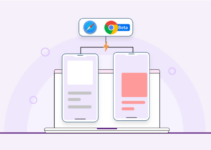In the dynamic realm of mobile app development, prioritizing quality assurance is of the utmost importance. With a multitude of Android devices dispersed among users globally, guaranteeing the flawless performance of Android applications is an intricate endeavor. Although manual testing remains vital, it consumes time and is susceptible to human fallibility. This is precisely where automation testing emerges as the solution, equipping developers and testers with a potent instrument to ensure the functionality, stability, and user contentment of apps.
The Significance of Automated Testing for Android Apps

Source: premiumstaff.co.uk
Android apps manifest in diverse forms and dimensions, serving a wide array of user requisites. Nevertheless, this assortment also introduces obstacles concerning compatibility and performance across an array of devices, screen proportions, and operating system iterations. Automated testing introduces a methodical approach to surmounting these hurdles. You can leverage automation testing with cloud based browser testing platforms such as https://www.lambdatest.com/real-device-cloud.
Automated testing involves the use of scripts and tools to execute test cases, validate app functionality, and identify defects. Unlike manual testing, automated tests can be run repeatedly, ensuring that no regressions occur during development. This approach not only saves time but also improves accuracy, allowing for comprehensive testing of different scenarios that might be impractical to cover manually.
Introduction to Appium: A Versatile Open-Source Automation Tool
Appium emerges as a key player in the realm of Android app automation. This open-source, cross-platform automation framework caters to both native and hybrid apps, making it an ideal choice for diverse application types. Appium leverages the WebDriver protocol, enabling testers to interact with app elements just as a user would, be it clicking buttons, entering text, or swiping across screens.
What sets Appium apart is its cross-platform compatibility. It supports not only Android but also iOS, streamlining testing efforts for applications developed for multiple platforms. Furthermore, Appium supports various programming languages, including Java, Python, and JavaScript, making it accessible to a wide range of developers and testers.
Leveraging Cloud-Based Automation for Scalability and Efficiency

Source: reviewed.usatoday.com
While Appium itself enhances the efficiency of automated testing, cloud-based automation takes it a step further by addressing scalability and resource challenges. As the demand for Android apps surges, so does the necessity to test them on a plethora of devices and configurations. Managing a physical fleet of devices can be daunting and resource-intensive. This is where cloud-based automation enters the picture.
Advantages of Cloud-Based Automation:
- Scalability: Cloud platforms offer the capability to run tests on multiple devices simultaneously. This parallel execution drastically reduces testing time, providing quicker feedback on app performance.
- Cost Efficiency: Traditional testing setups require significant investments in physical devices and infrastructure. Cloud-based automation operates on a pay-as-you-go model, minimizing upfront costs.
- Resource Management: Cloud-based automation eliminates the need to manage and maintain physical devices. This includes tasks such as updates, repairs, and storage, enabling teams to focus on testing rather than device upkeep.
Considerations for Adopting Cloud-Based Automation:
While the benefits of cloud-based automation are evident, there are certain considerations to bear in mind before taking the plunge:
- Security and Data Privacy: Storing app builds and sensitive data on the cloud raises concerns about security. Choosing a cloud provider that adheres to industry standards and offers robust security measures is crucial.
- Network Latency and Stability: Cloud-based testing relies on stable and low-latency network connections. Any disruptions in connectivity can impact test execution and result accuracy.
- Compatibility with Cloud Platforms: Different cloud platforms come with varying features and capabilities. Ensuring that the chosen platform aligns with your testing requirements and tools, such as Appium, is essential.
Setting Up Appium on a Cloud Platform

Source: digitnews.in
As the foundation of successful cloud-based automated testing, setting up Appium on a cloud server requires careful attention to detail. Here’s a step-by-step guide to help you get started:
- Choosing a Cloud Provider: Evaluate cloud providers like AWS, Google Cloud, or Azure based on factors such as pricing, available resources, and integration capabilities.
- Installing Dependencies: Begin by installing necessary dependencies on the cloud server. This includes Java Development Kit (JDK), Android SDK, and any other tools required by Appium.
- Configuring Appium Server: Set up the Appium server on the cloud instance. This involves installing the Appium package and configuring it based on your testing requirements.
- Android Emulators or Virtual Machines: Create and manage Android emulators or virtual machines on the cloud. These will serve as the testing environment for your app.
- Establishing Connectivity: Ensure that there’s a seamless connection between the Android emulators and the Appium server. This might involve configuring network settings or establishing tunnels for communication.
With Appium set up on the cloud, you’re now ready to dive into designing effective automation tests.
Designing Effective Automation Tests
The key to successful automated testing lies in the design of your test scripts. Here’s how to create robust and maintainable test scripts using Appium:
- Test Case Selection: Begin by selecting suitable test scenarios for automation. Focus on critical user flows and functionalities that have a significant impact on the app’s performance.
- Utilizing Appium’s WebDriver Commands: Appium’s WebDriver offers a wide range of commands to interact with app elements. Familiarize yourself with these commands to simulate user interactions effectively.
- Handling Waits, Assertions, and Synchronization: Since app interactions might not occur instantaneously, proper synchronization and waiting mechanisms are crucial. Implement assertions to validate expected outcomes.
- Implementing Page Object Pattern: Organize your test code using the page object pattern. This design pattern separates the test logic from the app’s UI structure, enhancing maintainability.
- Naming Conventions and Code Structure: Adhere to consistent naming conventions and maintain a structured codebase. This enhances readability and collaboration among team members.
Running Appium Tests on Cloud Infrastructure:

Source: cnet.com
Automating Android app testing using Appium on the cloud brings a new level of efficiency and scalability to the testing process. In this segment of our guide, we’ll delve into the key aspects of running Appium tests on cloud infrastructure, including creating test suites, parallel execution, utilizing cloud-based test management tools, collecting and analyzing results. We’ll also explore the challenges of cloud-based automation and how to integrate it seamlessly into your CI/CD pipeline. Let’s dive in.
Creating a Test Suite and Configuring Test Execution
Creating a well-structured test suite is the foundation of an effective testing strategy. A test suite groups related test cases, making it easier to manage and execute them collectively. When setting up your test suite for cloud-based automation, consider the following steps:
- Categorize Test Cases: Group test cases based on functionalities, features, or user scenarios. This logical categorization enhances test organization and allows you to focus on specific aspects during test execution.
- Prioritize Test Cases: Identify critical test cases that cover core functionalities and user workflows. Prioritize these test cases to ensure they receive sufficient attention during automated testing.
- Configure Test Execution: Define how your test suite will be executed on the cloud. Decide the order in which test cases will run and if any dependencies exist between them. This configuration ensures a smooth test execution flow.
Parallel Test Execution: Maximizing Efficiency Through Multiple Devices
Cloud-based automation’s most significant advantage is the ability to execute tests in parallel on multiple devices simultaneously. This feature dramatically reduces test execution time and accelerates the feedback loop for development teams. Instead of sequentially testing each scenario on a single device, cloud-based automation enables tests to be distributed across various devices concurrently.
Using Cloud-Based Test Management Tools to Schedule and Monitor Tests

Source: medium.com
Cloud-based test management tools provide a centralized platform for scheduling, managing, and monitoring test runs. These tools offer features such as:
- Scheduling: Set up automated test runs at specific times or intervals. This ensures consistent testing and minimizes manual intervention.
- Real-Time Monitoring: Track the progress of test execution in real time. Receive notifications for test failures and successes, enabling quick response to issues.
- Historical Data: Access historical test results and logs. This data aids in tracking trends, identifying recurring issues, and measuring improvements over time.
Collecting and Analyzing Test Results: Logs, Screenshots, and Reports
Automated tests generate a wealth of data that provides insights into the app’s performance and behavior. Cloud-based automation platforms often offer mechanisms to collect and analyze this data:
- Logs: Capture detailed logs from test runs. These logs can reveal the sequence of actions, interactions with the app, and any errors encountered during testing.
- Screenshots: Capture screenshots at key points in your test scenarios. Screenshots provide visual evidence of test outcomes and can aid in diagnosing issues.
- Reports: Generate comprehensive test reports that summarize test outcomes, failures, and successes. These reports facilitate clear communication among team members and stakeholders.
Overcoming Challenges in Cloud-Based Appium Automation
While cloud-based automation offers numerous benefits, it’s important to address the challenges that can arise when testing on remote infrastructure:
Dealing with Network-Related Issues: Latency, Stability, and Firewalls
Network connectivity is crucial for cloud-based testing. Latency and stability issues can impact the timing of interactions and result in synchronization problems. Ensure a stable and low-latency network connection for consistent test execution. Address firewall configurations to enable seamless communication between cloud resources and testing devices.
Handling Variations in Cloud Virtual Machines: Performance, Screen Sizes, OS Versions

Source: healthline.com
Cloud virtual machines come in various configurations, mirroring the diversity of real-world devices. Your automated tests should be adaptable enough to handle variations in performance, screen sizes, and operating system versions. Design your tests to be responsive to these variables, ensuring consistent behavior across different testing environments.
Managing Test Data and Environment Setup for Consistency
Maintaining consistency in testing environments is crucial for reliable results. Manage test data and ensure that required resources are available for each test run. Implement mechanisms to reset and clean up the testing environment after each test cycle, ensuring a consistent baseline for testing.
Continuous Integration and Continuous Deployment (CI/CD) with Cloud-Based Automation
Integrating automated tests into your CI/CD pipeline brings automation to the heart of your development process. This integration ensures that automated tests are seamlessly executed as part of every code commit.
Integrating Automated Tests into CI/CD Pipelines

Source: linkedin.com
Automated tests should be seamlessly integrated into your CI/CD pipeline. Automate the execution of tests whenever new code is committed to the repository. This integration ensures that new changes are thoroughly tested before deployment.
Automating the Deployment of Android App Builds for Testing
Sync your CI/CD pipeline with the cloud infrastructure to automate the deployment of Android app builds for testing. This synchronization guarantees that the version being tested matches the code under review, minimizing discrepancies between development and testing environments.
Running Automated Tests as Part of Every Code Commit
Integrating automated tests into the CI/CD process ensures that tests are executed with each code commit. This practice helps identify issues early in the development cycle, reducing the likelihood of bugs entering later stages and enhancing overall software quality.
Ensuring Reliable and Fast Feedback to Developers
Immediate feedback to developers is a cornerstone of effective CI/CD. Automated tests running on the cloud offer rapid insights into app health. Developers receive prompt feedback, enabling them to address issues swiftly and maintain a fast-paced development cycle.
Monitoring and Maintenance

Source: today.com
As your cloud-based Appium automation suite becomes an integral part of your testing strategy, continuous monitoring and maintenance are key to its success.
Monitoring Test Execution on the Cloud Platform
Regularly monitor the execution of tests on the cloud platform. Track test progress, resource utilization, and any anomalies. Timely intervention can prevent disruptions in testing activities.
Managing Resources Efficiently: Scaling Up/Down as Needed
Cloud platforms provide the flexibility to scale resources up or down based on demand. Optimize resource usage to balance costs while ensuring sufficient resources for parallel test execution.
Regular Maintenance of Automation Scripts: Handling App Updates, Changes in UI
Mobile apps evolve over time with updates and changes in the user interface. Regularly update your automation scripts to accommodate these changes. This maintenance ensures that your scripts remain aligned with the app’s current state.
Continuous Improvement: Iteratively Enhancing Test Coverage and Reliability
Automation is a journey of ongoing improvement. Identify gaps in test coverage and expand scenarios to cover new features. Analyze test failures to strengthen the reliability of your test suite.
You can leverage LambdaTest for automating Android app testing. It is a digital experience testing platform designed to streamline the testing process for web and mobile applications. It offers compatibility with 3000+ test environments including real device clouds, making it an ideal choice for Android app testing. This compatibility extends not only to various Android devices but also to different screen sizes and OS versions, ensuring comprehensive test coverage.
Conclusion
In this segment, we’ve explored the intricacies of running Appium tests on cloud infrastructure. We’ve covered the creation of effective test suites, the power of parallel execution, the benefits of cloud-based test management tools, and the significance of collecting and analyzing test results. Moreover, we’ve addressed the challenges of cloud-based automation and examined its seamless integration into CI/CD pipelines. Lastly, we’ve highlighted the importance of monitoring and maintenance for a sustainable and efficient testing strategy.
As we move forward, the final part of this guide will provide a comprehensive conclusion, recapping the benefits of automating Android apps using Appium on the cloud. It will emphasize how this approach streamlines the testing process, encourages efficiency, and enhances overall app quality. Stay tuned for the conclusion of this journey into the world of cloud-based automation and its impact on Android app testing.




